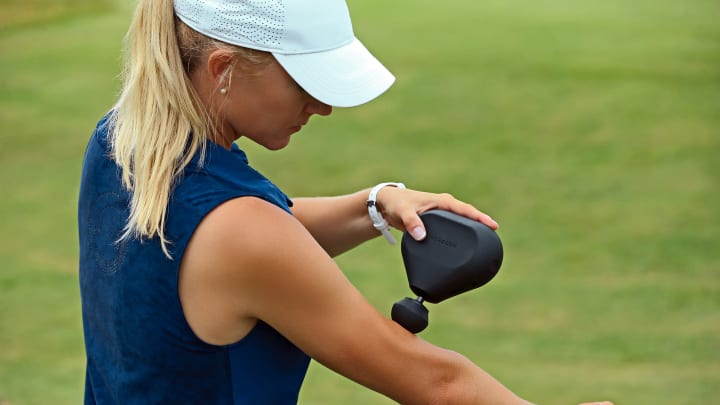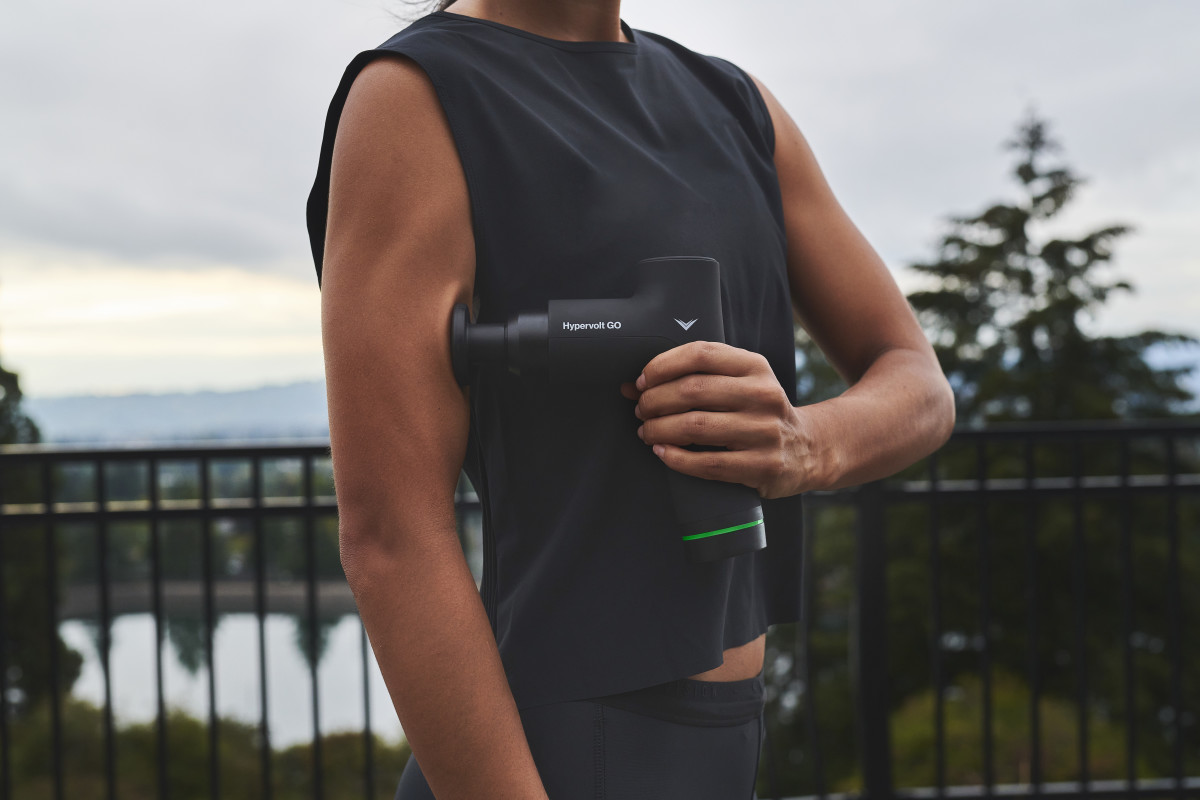Percussion Therapy Devices (Massage Guns) Helping to Eliminate Pain From the Gain

Golf presents one of sport’s most engaging paradoxes: avowed as a non-contact sport, the very essence of the game remains impact. Of course, most recreational golfers do not beat hundreds of range balls a day or compete on a weekly basis as the Tour pros do. The sport has its way of dishing out varying degrees of musculoskeletal discomfort and sometimes serious injury to anyone who frequents the links on any kind of regular basis.
There’s a gallant hero, however, thumping to the rescue of aching swingers everywhere in the form of today’s percussion therapy devices, better known vernacularly as massage guns.
Therabody’s Theragun series and Hyperice’s Hypervolt models represent the industry leaders in an increasingly crowded market. Their massage guns are being used increasingly by many within the athletic and medical professions, as well as commercially. They are designed to deliver increased muscle relaxation, a greater range of motion and flexibility, as well as quick recovery and relief from the pain, stiffness and soreness resulting from overused golf muscles.
Renowned golf teacher David Leadbetter and two-time major champion Collin Morikawa are spokesmen for Therabody. Hyperice boasts Rickie Fowler, Tony Finau, Sungjae Im and Cameron Smith as its golf ambassadors — and investors in the company.
“Golfers can warm up for three minutes before a round of golf or a practice session with a massage gun that otherwise would take them 25 minutes of stretching and warm-up exercises to accomplish without one,” Leadbetter said. “The way I use it teaching-wise is to get the player to focus on his or her calves, glutes, quads, hip flexors by treating those areas with the Theragun. So, while it’s mainly the lower body as well as the shoulder and trapezius areas that we target, the Theragun also really help the wrists and forearms.
“I think to work the soft tissue and getting the golfer’s blood flowing allows the body as a whole to function more efficiently and therefore the golfer can work into their swings what we’re focusing on in the lesson and ultimately they will swing the club better.”
Therabody and Hyperice share a vision of building their brands around facilitating an athlete’s recovery versus developing training protocols or products. Both massagers are extensively researched commercial-grade products. They employ rapidly pulsing piston-like arms that accommodate an alternating array of head attachments to deliver at right angles to their targeted body areas. Sent in a steady stream of jabs — that in some of the devices exceeds 2,000 pumps per minute — the devices allow users to modify the intensity of their treatment through multiple speed settings and by encouraging the user to use only as much pressure as can be comfortably tolerated.
The Theragun Pro ($599) and Hyperice Hypervolt Plus ($329), which weigh about 3 pounds each, represent the company’s largest and most powerful massagers. Two considerably smaller and lighter products — the Theragun Mini and the Hypervolt Go — each sell for $199 and weigh about 1.5 pounds. All of the Theragun and Hypervolt massage gun models have TSA approval for carry-on air travel. All of the massagers come with rechargeable lithium-ion batteries and chargers, whose charge time depends on the product size.
The USGA has deemed these hand-held massage devices conforming to the Rules of Golf and thus permissible for golfers to use during competitive rounds of tournament play. Those with Bluetooth connectivity capability, however, do not conform due to inherent advantages caused by other devices, such as cell phones.
Each of the companies’ massagers excel for different reasons. Theragun’s triangularly shaped handle receives accolades from reviewers for its ergonomic design and ease of use in reaching hard-to-access massage places, such as the upper back and shoulder areas. The Hypervolt massagers garner praise for their whisper-quiet performance. In fact, noise reduction and easy usage is ongoing as technologies evolve.

But why do golfers’ muscles get tight and hurt in the first place? And how do percussion massage therapy devices come to the rescue?
Tim Roberts, Therabody’s director of science and innovation, answers the first question almost poetically.
“Movement is the language of our muscles,” he said, “and golfers get tight because their golf swings ask them to repeat a movement in a range of motion in which they do not typically move, often because they sit at a desk all day.
“Therefore, the stress they place on areas of their body and its subsequent fatigue causes their nervous system to increase tone or tension in certain areas as a protective mechanism. This can create muscle, joint and connective tissue pain in and of itself, but also this stress can additionally cause soreness from the micro-damage to the muscles used in the repetitive movement. When we are tight we often then further narrow our normal movement patterns, which restricts our golf swings even more, which causes more pain in a true vicious cycle pattern.”
Roberts adds that these pulsating percussive therapy guns “help reduce or eliminate pain through modulating the nervous system as the pressure being applied by the massage device blocks the pain signals to the brain and the vibration element of the massage works through vibratory analgesia to code them differently.”
This allows the body to pump more oxygen and nutrients into tissues and vital organs, and fatigued areas become more flexible and recover at an accelerated rate.
The devices are not specific to just golf.
“Do What You Love. More” serves as Hyperice’s newly launched motto and CEO Jim Heuther says his company’s mission is to improve the overall health and wellness of anyone. To that end, Hyperice recently acquired mental wellness company Core and created a mind technology division. Heuter, though, would like “every human on earth to have and use one of our Hypervolts.”
If nothing else, the PGA Tour. In October 2020, Hyperice was named the official recovery device for the PGA and Champions tours, and provides all players with the latest versions of its products.
Similarly, Therabody and clubfitter Club Champion have engaged in a pilot project. Theraguns are being used in 40 Club Champion locations, and customers are encouraged to use them in warming up before club-fitting sessions.
“The idea here is that a golfer with warmed-up, more-flexible and relaxed muscles will make their best swings while getting fit which will help the Club Champion fitter more confidently find the golfer’s optimal club model and specs,” said Rob Chase, director of global business development for Therabody. “This will enable golfers to make the most informed decision possible when the fitting session comes to completion should they decide to buy a club or a set of clubs.”
Ben Hogan, when asked the key to playing great golf, said, “The secret is in the dirt; go and dig it out of the dirt.”
Hogan also was known to hit so many golf balls on the driving range each day that his hands bled each night. Golfers today can rest assured that a restoring, relaxing and rehabilitating rub is available in the form of these emerging massage therapy devices.
